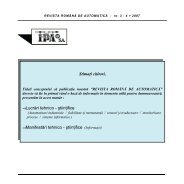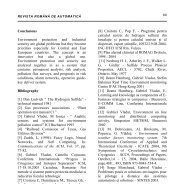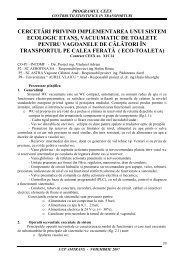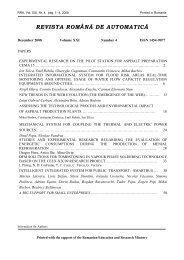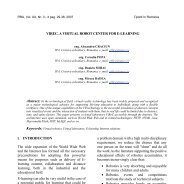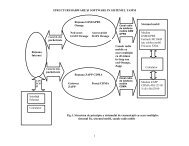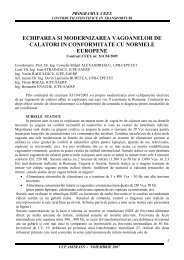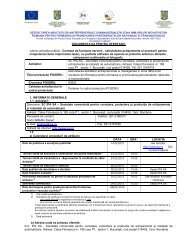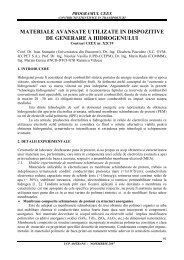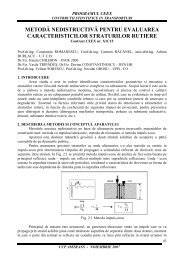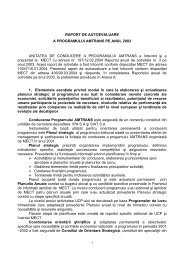0_ CUPRINS - IPA SA
0_ CUPRINS - IPA SA
0_ CUPRINS - IPA SA
You also want an ePaper? Increase the reach of your titles
YUMPU automatically turns print PDFs into web optimized ePapers that Google loves.
sections (excepting the Introduction), starting with the with<br />
the presentation of the state of art in the field, the<br />
concept/architecture of the system, results of some field tests,<br />
and conclusions regarding the advantages that the solution<br />
presents.<br />
Fig 1. <strong>SA</strong>FETRAFF – General architecture<br />
On line monitoring of the road vehicles flow and the<br />
detection of the traffic incidents will be accomplished by<br />
installing several web cameras provided fixed IP and<br />
featuring images storage on a central server. Collected data<br />
will be on line transmitted to the data server, installed at the<br />
premises of the Monitoring and Control Center. The<br />
information will be accessed by fixed or mobile devices<br />
The pilot system has been tested in several cities of<br />
Romania, namely Suceava, Sibiu and Bucharest.<br />
There are many levels where such systems may be<br />
implemented, depending on the traffic volumes, starting<br />
from the simple static signaling systems and going up to<br />
management systems based on complex algorithms that<br />
consider a series of key factors. There are, also, several ways<br />
that the traffic fluency, safety and the level of emissions can<br />
be kept under control . Studies and implementations of<br />
different traffic management systems, combined with<br />
geometric re-arrangement of the road infrastructure showed<br />
that the best approach is to employ a combined strategy: with<br />
a contribution of 5% to 15% in traffic fluency improvement,<br />
the Urban Traffic Control systems cannot be completely<br />
effective without introducing also modifications in the road<br />
geometry, or other factors that help increase overall road<br />
infrastructure capacity. However, the less expensive in this<br />
equation is the introduction of intelligent transport systems<br />
technologies. Recently, Multimodal Real Time Traffic and<br />
Travel Information (RTTI) [2] services proved to be an<br />
effective instrument to decrease energy consumption in<br />
urban areas across the different modes of transport, by<br />
changing the mobility behavior (the modal shift) for the<br />
single traveler. The European Union has also a permanent<br />
concern in reducing the number of traffic incidents and<br />
injuries. The EC documents [1], related to traffic, clearly<br />
state that road safety is one of the major concerns and<br />
“finally, users expect more rational transport in towns and<br />
cities. Noise and air pollution and their effects on health are<br />
of greater concern in towns and cities, and a clear line needs<br />
to be drawn urgently between the respective roles of private<br />
cars and public transport.” The paper is structured in four<br />
II.<br />
CONCEPT AND SYSTEM’S ARCHITECTURE<br />
Safetraff system is designed to produce relevant safety<br />
and quantitative information regarding the road traffic itself.<br />
This contributes to traffic safety, having embedded specific<br />
functions for law enforcement.<br />
The architecture traffic monitoring subsystem consists of<br />
the following functional components:<br />
• The data collection component;<br />
• The central dispatcher component;<br />
• The CCTV (web-based) component for traffic<br />
monitoring and video management of traffic<br />
incidents;<br />
• The web interface.<br />
Fig. 2 The functional architecture of the traffic information subsystem<br />
Figure 2 depicts the physical architecture of the<br />
“SafeTraff” platform. The main part is the infrastructure for<br />
data collection. This component employs non-intrusive,<br />
passive infrared (PIR) sensors for vehicle sensing. Specific<br />
modules employ local data processing in order to build<br />
traffic information messages that are sent in specific blocks<br />
to the communication functional block. The vehicle sensors<br />
are capable of detecting presence, occupancy, speed, and<br />
vehicle classification. These categories of traffic sensors do<br />
not need civil construction works for mounting, therefore<br />
their installation costs is being kept low. The sensors are<br />
used to form data messages from each intersection, which<br />
are locally processed in a special unit, called device for<br />
traffic data processing and communications (TDPC). The<br />
device also ensures the local power supply control, local<br />
communications with the sensors and the communication<br />
monitoring with the central dispatcher unit. The set of<br />
detection sub-systems communicate via the same GSM<br />
GPRS network with the central computer. Data from the<br />
sensors is locally stored in a temporary memory (for safety<br />
purposes) and periodically read (each 5 s – to 5 min,<br />
configurable). A specific set of messages containing<br />
information regarding the number of vehicles counted,<br />
classification, the degree of occupancy etc. is formed after.<br />
8



